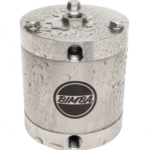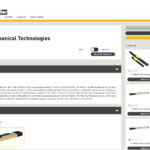Updated May 2018 || Electrons or air molecules? That’s not a question you hear very often, but it’s one that engineers and designers wrestle with when developing a new machine or process. That’s because a wide range of linear actuators, especially rod-type versions, are available either electrically driven or pneumatically driven. The choice of which to use depends on many factors—from application requirements to energy efficiency concerns.
The term electric actuator encompasses many drive technologies — ball screw, lead screw, belt, rack and pinion, and linear motor.
A comparison between pneumatic and electric actuators typically includes ball screw and belt driven electric actuators, as their performance capabilities have the most overlap with pneumatic technology.
Belt driven actuators are capable of traveling long lengths at fast speeds, while ball screw driven actuators provide high thrust forces and very precise positioning. And if the comparison involves rod-type actuators, the electric version would almost certainly be ball screw driven.
When pneumatic actuators make sense

Pneumatics provide both high speed and force in a small footprint. They are best suited for fast, point-to-point movements, and can withstand hard stops without damage. Applications that require many actuators in the same process benefit from the ease of pneumatic installations and the ability to drive many devices from a single compressor.
In applications that require explosion-proof components, or where there are other environmental safety concerns, such as heat build-up, pneumatic linear actuators are typically preferred over electric versions
Despite their low initial cost, operating and maintenance costs can be the bane of pneumatic installations. That’s why it’s important to ensure that the compressor and other air handling equipment are properly sized.
Compressed air is a consumable, like electricity, and a compressor that’s not fully utilized can be a large cost sink. Pressure losses throughout the air delivery system can reduce efficiency and increase operating costs significantly, so regular maintenance is critical.
The main consideration for pneumatic applications is whether the facility is already equipped for air preparation and delivery.
In most industrial operations, the necessary infrastructure will already be in place. Then, the decision regarding pneumatic or electric linear actuators will come down to suitability for the application and the scale of the operation. With pneumatics, connecting more devices typically results in better utilization of the supporting hardware without a significant increase in complexity of the system, so large-scale deployments are preferred to one-off implementations.
The case for electric actuators
Electric linear actuators are typically connected to a stepper or servo motor, which enable accurate positioning along the entire stroke. With feedback and control, processes that require varying speeds and forces or intermediate positioning are no problem for electric actuators. Adjustments to operating parameters are also easier with electric actuators than with pneumatic versions. Move profile, stroke, and duty cycle can all be adjusted within the control, without changing components (provided, of course, the new parameters are within the capabilities of the actuator), which is often not the case with pneumatic actuators. The high level of control available with electric actuators, however, comes at a price—requiring an experienced controls programmer and significant time to connect, set up, and tune the system.
Although the upfront equipment costs for electric linear actuators are generally higher than for pneumatic actuators, electric versions often benefit from a lower total cost of ownership, with relatively predictable operating costs and straightforward maintenance requirements. Most electric actuators require only periodic lubrication of the rotating components, such as the ball screw or linear bearings, where pneumatic actuators require frequent inspection and adjustment of air hoses, valves, and fittings. Unlike pneumatic actuators, which can generate significant noise, electric actuators are relatively quiet when properly tuned and operated.

Total cost of ownership comparisons between pneumatic and electric linear actuators include many variables and assumptions about operating time, utilization, replacement frequency, and electricity costs. This makes it impossible to say that one technology is always, or even usually, more cost-effective than the other. But for applications that need intermediate positioning or very precise control, electric linear actuators are a valid first consideration. On the other hand, for applications that call for fast, point-to-point movements, or that require a significant number of devices, pneumatic linear actuators are a logical first choice.
Feature image credit: wiseGEEK.com












Leave a Reply
You must be logged in to post a comment.